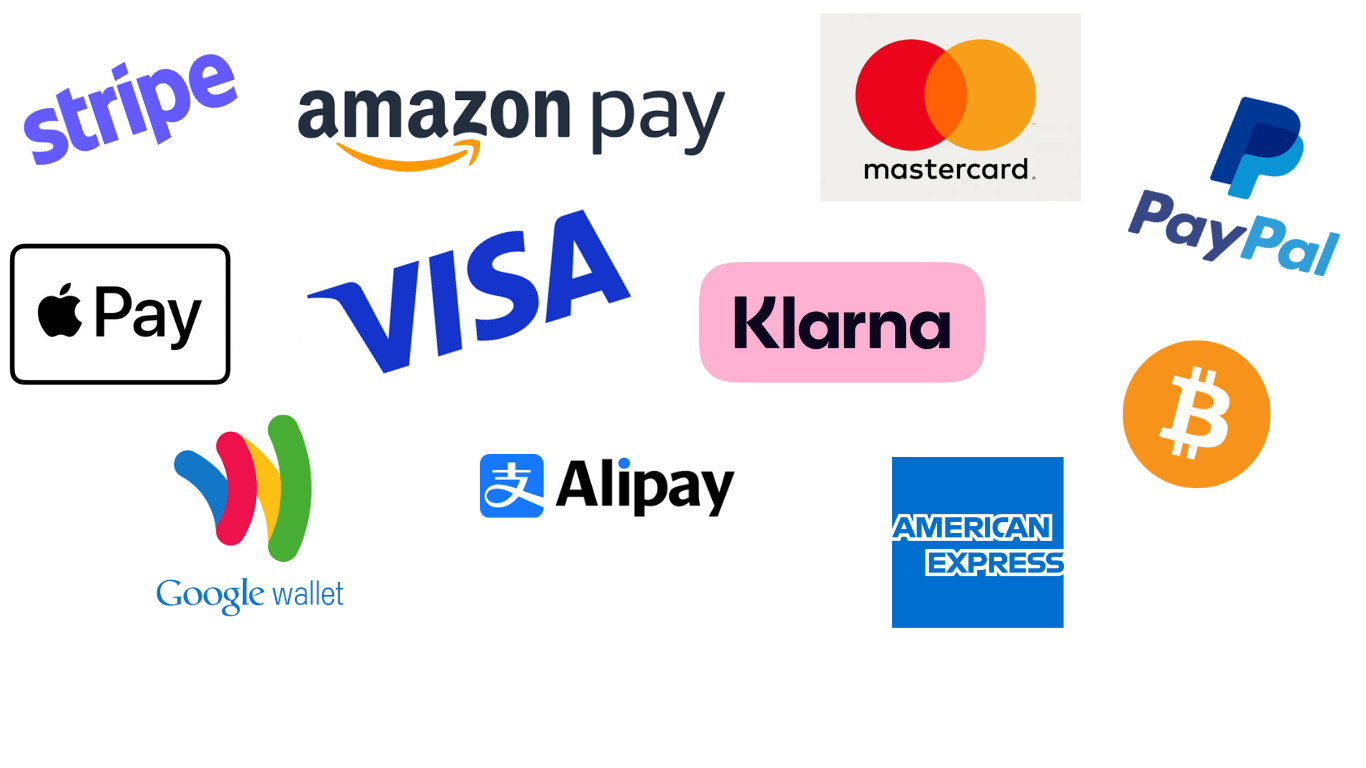What are the Online Payment Options for E-commerce

When you are setting up an of e-commerce website, it is important to have a diverse payment option, this will help in atracting and retaining customers.
In the past I have made the mistake of not having enough options to take orders, so I actually lost customers as a result!
I only had one payment method, you need at least or 3 or more! Don’t make the same mistakes as I did in the early days! 🙂
My main objective of this article is to inform readers about various online payment methods and their benefits, helping businesses choose the best options for their customers.
What are the best payment methods for a website to use?
Although there is now easy straightforward answer here, I can advise that some of the most popular payment methods include Paypal, Klarna, World Pay, Credit and Debit cards, at the very least those are the ones I have used or have offered.
Now, although these are arguably the most popular payment methods available, there are many more, and quite often it depends on what it is your selling.
For instance If you’re selling low cost goods then methods such as bitcoin or any associated altcoin would probably not be the best way to take payment.
Also it is worth pointing out that in some instances if you are selling a high-end item you can put in place monthly pan options such as Klarna, amounts can be broken up over a certain amount of time.
List of Payment Types for E-commerce
Credit and Debit Cards
- Widely accepted and commonly used for online transactions.
- Secure with fraud prevention measures.
- Visa: One of the most recognized and used cards globally.
- MasterCard: Another major player with extensive international reach.
- American Express: Known for premium services and strong customer support.
- Discover: Popular in the U.S. with rewards programs and no foreign transaction fees.
Digital Wallets
- Allow customers to store payment information and make quick, secure payments.
- Often integrated with mobile devices for added convenience.
- PayPal: A leading digital wallet service with buyer protection features.
- Apple Pay: Enables payments using Apple devices with added security like Face ID.
- Google Wallet: Google’s payment service that works with Android devices.
- Samsung Pay: Samsung’s mobile payment service with magnetic secure transmission.
- Amazon Pay: Utilizes customers’ Amazon account information for seamless transactions.
Payment Gateways
- Facilitate online payments by connecting merchants to financial institutions.
- Ensure secure and reliable transaction processing.
- Stripe: Popular for its developer-friendly API and robust features.
- Square: Known for its simplicity and flat-rate pricing.
- Authorize.Net: A long-established gateway with a range of customization options.
- Braintree: Offers seamless integration with various platforms and supports multiple payment methods.
- 2Checkout: Supports global transactions and multiple currencies.
Buy Now, Pay Later (BNPL) Services
- Allow customers to split payments into installments, often without interest.
- Attractive to consumers looking for flexibility.
- Afterpay: Popular in the fashion and beauty sectors.
- Klarna: Offers multiple payment options, including pay later and financing.
- Affirm: Provides clear terms with no hidden fees.
- Sezzle: Focuses on interest-free installment plans.
- Splitit: Uses customers’ existing credit to break payments into installments.
Cryptocurrencies
- Digital currencies that offer decentralized payment options.
- Increasingly accepted by tech-savvy consumers.
- Bitcoin: The most well-known and widely accepted cryptocurrency.
- Ethereum: Offers smart contract capabilities along with payments.
- Litecoin: Known for faster transaction times compared to Bitcoin.
- Ripple (XRP): Focuses on real-time international payments.
- Bitcoin Cash: An offshoot of Bitcoin with larger block sizes for faster processing.
Mobile Payment Services
- Use mobile devices for quick and easy payments.
- Often linked with other payment methods for versatility.
- Venmo: Popular among younger users for its social payment features.
- Zelle: Allows bank-to-bank transfers within the U.S.
- WeChat Pay: Widely used in China, integrated with the WeChat app.
- Alipay: Another major payment method in China with extensive merchant support.
Bank Transfers
- Direct transfers from a customer’s bank account to the merchant’s account.
- Lower fees but may take longer to process.
- Direct Bank Transfers: Simple and straightforward, often used for larger transactions.
- ACH Transfers: Automated Clearing House transfers used in the U.S. for electronic payments.
- SEPA Transfers: Single Euro Payments Area transfers for euro-denominated transactions in Europe.
Prepaid Cards
- Preloaded with funds and used like a debit card.
- Useful for budgeting and avoiding credit.
- Visa Prepaid: Can be used anywhere Visa is accepted.
- MasterCard Prepaid: Similar to Visa, accepted globally.
- American Express Serve: Includes online account management and direct deposit options.
Alternative Payment Methods
- Other non-traditional methods catering to specific needs or preferences.
- Cash on Delivery: Customers pay in cash upon receiving the goods.
- E-Checks: Electronic version of paper checks.
- Money Orders: Secured payments for sending large sums.
- Western Union: Allows sending and receiving money across the globe.
Regional Payment Options
- Specific to certain regions, catering to local preferences and banking systems.
- iDEAL (Netherlands): Direct online transfers from Dutch bank accounts.
- SOFORT (Germany): Facilitates direct bank transfers in several European countries.
- Giropay (Germany): Similar to SOFORT, widely used in Germany.
- Interac (Canada): E-transfer system commonly used in Canada.
- JCB (Japan): Credit card widely accepted in Japan.
- UnionPay (China): Leading payment method in China, accepted internationally.
1: Credit and Debit Cards
Credit and debit cards are among the most popular and widely accepted payment methods in e-commerce. What they bring is convenience and are trusted by consumers worldwide, also the vast majority of customers you will come across will likely have this method available to make any payment.
Major payment providers include Visa, MasterCard, and American Express, as these tend to be main stream you will always get robust security features like CVV (Card Verification Value) and 3D Secure authentication to protect against fraud, something many people like when making payments online.
Pros:
- Widespread acceptance and familiarity
- Immediate processing of transactions
- Security features to prevent fraud
Cons:
- Transaction fees for merchants
- Potential for chargebacks and fraud
- May not be accessible to all customers due to credit requirements
My Final Thoughts
Ultimately what you’re looking for is a payment method which is suitable for you, more importantly for your customer, as without their money your business is going nowhere.
Ideally, what I would recommend is to have at least two payment methods.
My approach over the years has been PayPal, as that is still a popular source of payments made directly, but people can also use their cards via the Paypal account.
However, always bear in mind not everybody has the only payment method you have set up, for example here, I came across a lot of customers Who don’t use PayPal, therefore it’s always wise to have a credit or debit card option, as the vast majority of customers will always have this as a means to pay.
Other useful payment Gateways I have used or have come across are Stripe and World pay, and often their fees can be less than what services like PayPal could charge, always do your due diligence and make sure you cover all fees and take them into account.







